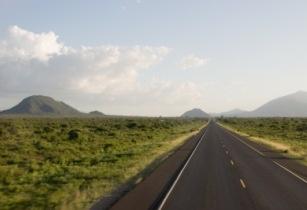The ongoing rehabilitation of the 507km Isiolo-Marsabit-Moyale road in Kenyas northern region is expected to open up new trade opportunities with Ethiopia and foster development in semi-arid areas
Expected to cost more than US$1.63bn, rehabilitation works started six years ago and has been scheduled for completion in 2014, according to the Kenya National Highways Authority (KeNHA). The road development has been funded by the African Development Bank (AfDB) and the Kenya government.
Last year, the construction of the 122km Turbi-Moyale road at a cost of US$176mn was launched, connecting Ethiopia to the Great North Road, which links Tanzania, Kenya, Ethiopia and Sudan.
The Kenyan section of the corridor starts at the Tanzanian border of Namanga, through Nairobi, Thika Super Highway-Isiolo and Marsabit, and terminating at the border with Ethiopia in Moyale.
Already, the US$350mn Thika Superhighway has been completed, with the northern section from Isiolo to Moyale, on the Ethiopian-Kenya border, under construction.
The town of Marsabit will also benefit from the construction of the Lamu Port-South Sudan-Ethiopia Transport and Development Corridor (LAPSSET), a project that will involve the development of an 800km road system, a standard gauge railway, a 1,300km oil pipeline, an oil refinery and an airport.
The projects form part of the LamuPort development – a joint venture by Kenya, Ethiopia and South Sudan that is expected to cost US$22.5bn. The three countries will share the cost of the project, which will be undertaken through a Private Public Partnership.
The African Union, COMESA, the East African Community (EAC), South African Development Community (SADC), AfDB, the World Bank and the International Finance Corporation (IFC) are all partners institutions in the LAPSSET project.
The completed section of the Isiolo-Marsabit-Moyale road have already created better opportunities and enhanced security to this volatile regions, which has been incessantly hampered by inter-ethnic conflicts over herding and water rights.
"We are now better connected to country – there is less insecurity and economically we are [better off] compared to before," remarked Hussein Dado, a resident of Marsabit, who said he was pleased at the prospects such a road would bring to the region. "With the opening up of the last Kenyan section of the Trans-Africa Highway Corridor, Northern Kenya will take off, with lots of economic activities."
According to Dado, new markets for livestock and their products are now in sight as communication with Nairobi’s Kenya Meat Commission slaughterhouse and the Port of Mombasa improves.
Government data shows that roads accounts for more than 95 per cent of the country’s total passenger and freight traffic, therefore playing a critical role in facilitating transportation and marketing of agricultural produce, while enhancing regional integration and promoting import-export trade.
According to the Kenya Roads Board (KRB), the country has a total of 160,886km of road, of which only 11,189km had been paved by 2009.
In order to streamline its road network across the country, the Kenya government plans to invest US$140bn in the next 15 year, according to the government officials.
Michael Kamau, cabinet secretary for roads, said, "Poor roads cannot support economic growth as envisaged in Vision 2030, the country’s development blueprint. We need to have a massive infrastructure upgrade to get to the economic status we are looking for as a nation."
To achieve these objectives, the government has developed the National Road Sector Investment Plan, expected to improve business environment for both local and international investors.
The Plan has been divided into three five-year phases, each with a first phase ending in 2015.
According to the plan, US$7bn will be spent on road improvements by the end of 2015.
The Kenyan government's investment in road construction and rehabilitation has also been on the rise since 2003. In the 2012/13 budget, infrastructure received one of the highest budgetary allocations to the tune of US$3.2bn for various projects, including roads, energy, rail and port development.
Of these funds, roads received US$1.5bn, an increase from the US$1.22bn allocated in the 2010/11 financial year.
Mwangi Mumero



